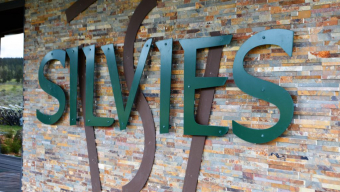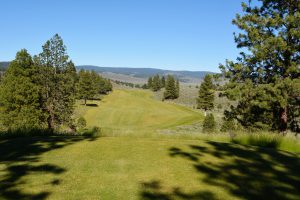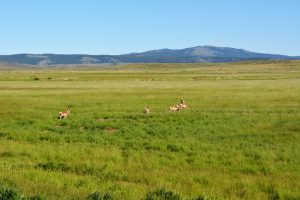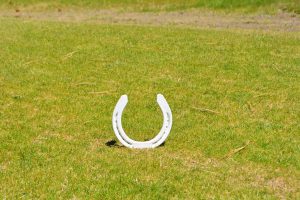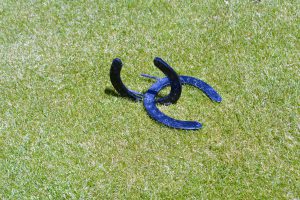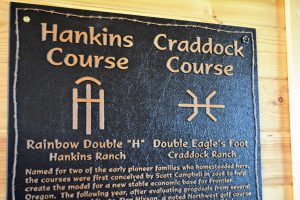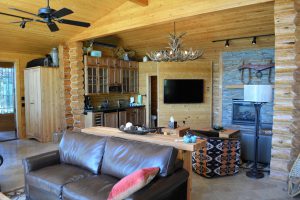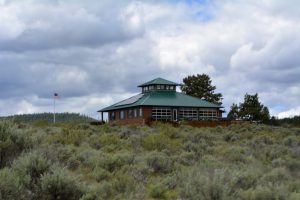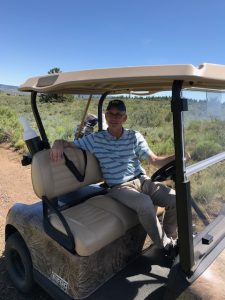SENECA, Or. — It’s as hard to imagine as it is to describe the design concept for one of America’s most unique new golf courses, the Retreat and Links at Silvies Valley Ranch in the high-desert isolation of Frontier Oregon.
It’s reversible. You can play it both ways, tee to green, green to tee. Two different courses; same terrain. (see picture)
No, you don’t play into another foursome coming toward you on the same fairway. Everyone plays one way one day and the other way the next day. Clockwise, counter-clockwise.
No, there are not 18 different tees, 18 different fairways and 18 different green complexes. For the most part, it’s all blended together, using 27 greens (nine at rest every other day) and 16 fairways. Tees, fairways and greens are all mixed and somehow you can work your way around without Google maps.
So, this must be sort of a gimmick course? Not really.
“I was worried that if this didn’t work, then it becomes a gimmick,” said course(s) architect Dan Hixson, a prominent Portland-based course designer who also plotted out Wine Valley in Walla Walla, Wa., and Bandon Crossings in Ore. “I think we avoided that.”
Indeed, it works. When you play the courses on back-to-back days you believe you are playing two different layouts. Essentially, you are. Each one is challenging, contrasting and memorable. You get two for the price of, well, two. What a concept.
So Hixson’s idea is changing the way America plays golf? Perhaps, going forward, but it’s not so new. In fact, it’s been here since hickory sticks and feathery balls.
“St. Andrews (Old Course) was designed to play that way (reversible),” said Hank Hickox, SVR’s chairman, formerly the GM for 17 years at the heralded Bandon Dunes on the southern Oregon coast. “No one’s built another one for 450 years.”
There have been a few reversible nine-hole courses built before noted course designer Tom Doak put together the first 18-hole complex in America, The Loop at Forest Dunes in Roscommon, Mich., which opened last June.
Well before The Loop opened, however, SVR had already started moving dirt, in 2010, and had a soft opening last year. It officially opened this month. Many of its features, the luxurious log-cabin lodging, the expansive spa/fitness center and the adjacent short nine-hole McVeigh Gauntlet – with ‘goat caddies’ – will be ready this month. The course(s) and most of the facilities have been in play for about a year.
“I want people to really love it,” Hixson said. “If golf isn’t fun, it’s really nothing.”
Fun was the project’s primary objective as directed by Dr. Scott Campbell, who, along with his wife Sandy, owns and operates this 140,000-acre goat-and-cattle ranch in remote Eastern Oregon, of which 260 acres has been devoted to the worship of the dimpled ball.
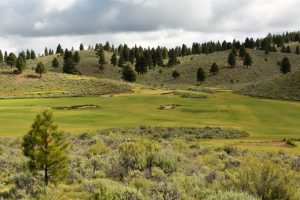
To the left is Hankins’ opening hole, a par-4, 415-yarder (surrounded by bunkers). To the right is Craddock’s final hole, a 315-yard, par-4
Campbell is a product of the region, as he and Sandy grew up in nearby Burns. He went on to become a veterinarian and moved to Portland. He become involved with the Banfield Pet Hospitals associated with PetSmart pet stores around the country and the franchise grew to more than 750 clinics.
Campbell sold his stake about a decade ago and purchased the Silvies property, first developed in 1883 yet through the succession of owners it had fallen into neglect and disrepair. In this part of remote and desolate Oregon – hard to reach even by accident – jobs, population and per-capita income are all sparse. Prairie dogs outnumber people by near infinity.
“The (lumber) mills closed a long time ago and no other industry came in,” Campbell said. “I graduated from high school in 1975 and there were 140 to 150 kids in my class. There were only 40 in last year’s graduation class.”
Campbell, not an avid golfer, was motivated to change that. He wanted the region to consider dipping a tee into tourism mainstream.
“What can we do for this community?” Campbell asked. “We’re trying to bring destination tourism to this part of Oregon, a lot like Bandon (Ore.). There was nothing in Bandon before the golf courses.”
Hickox, who was part of Bandon’s early development, added that Campbell “thinks it’s important to Frontier Oregon to have a nice resort and somebody had to do it first.”
Campbell had to convince the local authorities and state officials to think big. He held seminars at the Ranch to light a fire under the authorities and sought the necessary regulations to make it happen.
As for the course designer, Campbell was advised to bring in a splashy big-name architect to build it, subsequently drawing national attention. But he believed in Hixson, a highly underrated regional course artist.
Hixson, who started the project nearly a decade ago (“Dr. Campbell was never in a hurry”) had an rugged yet propitious piece of land to fit Campbell’s vision. It’s high prairie at 4,600 feet – the highest golf course in Oregon – with rolling hills, limited forests but an abundance of sagebrush and hardy wild fescue.
“I don’t know really what the others do. I’m not hung up on other architects,” Hixson said. “I try to find everything on the site that’s fine as it is. I hate building mounds. I try to keep what Mother Nature did.”
He moved very little dirt, weaving the course(s) in and around the slopes, across the plains and into the rolling hills. It was costly initially to build but ultimately water, irrigation and maintenance costs will be under par, relative to other courses.
Hixson, who knew he wanted to be a golf course designer by the time he was seven, got the reversible thing in his head as a youngster walking with his father around Eugene Country Club. What fascinated him was how that renown course was re-figured in the 1960s with the full 18 reversed into what is now one of America’s top 100 courses.
That concept stuck with him. He considered making a two- or three-hole reversible loop at Bandon Crossings and thought about it again at Wine Valley. During one of many walks with Campbell around the property in 2010, Hixson touched on the idea.
“We were drinking a lot of scotch, pretty good scotch,” said Campbell, who immediately thought it was an interesting idea.
“Dan is a golf historian extraordinaire,” Campbell said. “He said golfers love something that’s different. He talked about a (reversible) loop on the back nine. I said, ‘why not build the whole damn course like that.’ ”
There you go. Hixson had his directive – for the whole damn thing. His canvas had expanded exponentially in all directions. He was authorized to build two courses on the same plot, a daunting but exhilarating challenge that took him another five years to design, shape and complete.
The course(s) are all any golfer can handle. Named after original pioneer families in the region, the par-72 Craddock course is 7,035 yards while the par-72 Hankins course is 7,075 yards.
You’d be hard pressed to favor one over the other, just personal preference. The Hankins course has a more dramatic elevated tees and breath-taking vistas while the Craddock has some dandy par-3s.
Many of the fairways are extremely wide to accommodate the reversals. As you play, you can’t believe it’s the same terrain you played in the opposite direction the day before. Only on some large shared greens do you see where you approached and putted the previous round.
The greens, with three types of grasses, are beautiful, true yet hard to readily figure because of subtle undulations. It’s a links-like course, meaning dry, fast fairways, tight lies but much more elevation than a pure links course.
The fairway, with a lot of blue grass and natural fescue, has more fluff than, say, Bandon. That means it’s easier to get a wedge under the ball but also means the ball doesn’t roll as effortlessly and that makes it harder to hit short of the green and run it onto the putting surface. Hixson said the run-up will improve as the course(s) mature and the fescue takes over.
“This course is tremendously socially responsible,” Campbell added. “It uses low water and low labor.”
The course uses little or no pesticides. Instead, there are more than 5,000 bird houses attached to trees around the course. Mosquito-devouring blue birds and bats have taken up residence in the houses.
There are several creeks on the property and over the decades some have eroded waterways 10 to 15 feet deep. Campbell had the idea of filling some of the deeper creeks with rocks and debris. That has revitalized the natural water system. The process lifted the water tables closer to the surface and that, in turn and in time, tends to eliminate pesky tumbleweed and allow natural grasses to take over. That helps both grazers and golfers as well as river otters and beavers, who have returned in abundance.
One little critter that continues to be the bane of the maintenance crews is the prairie dog, who have dug thousands of entrance holes into their dens, indiscriminately on tees, fairways and in bunkers.
For all its costs, planning and anticipation, this is not a course(s) intended for the weekend golfer. “I don’t want,” Campbell said, “more than 50 people a day to play the course.”
As Hickox said two-in-one course concept, “is not a good financial model.” The critical component is real estate, as more than 200 luxury home sites are proposed in the hills above the course(s).
“It’s for people who are well traveled and looking for something different,” Hickox added. “It has a working ranch appeal. We don’t need a lot (of houses), just a few, not on the course but in the hills with great views of the valley.”
The green fees are comparable to other resort courses, such as Bandon, in the $250 range.
To be one of those 50 a day, it’ll take a five-hour drive south from Portland to get here, three hours west from Boise and eight hours southeast from Seattle. Once you find your way to this land of desolate beauty, you leave your car outside the gate and are given a golf cart for your stay.
The 36 cabins, designed for two twosomes, are pricey, beginning around $350 a night. They are well-appointed with hot tubs and big screen TVs as well as rustic touches such as original ox yokes from folks coming through on the Oregon Trail. Package deals can be found on the resorts web site.
There is also a lengthy airstrip nearby intended for PXG crowd.
Once inside the gates, you are treated royally with access to the luxury spa/fitness center, ready for use this month, the remodeled log-cabin Saloon Bar and dining center and the hillside ‘Hideout’ clubhouse a half mile up the sloop with its outdoor patio to view the valley and the green fairway ribbons.
Just below the Hideout is a nine-hole, par-three course called Chief Egan that is a delight to play. Adjacent to Craddock’s 18th hole is the McVeigh’s Gauntlet, a quirky, slopey seven-hole course that features a par-2 hole that requires merely a putter. This course also features the “goat caddies,” as a handful of the 3,500 goats on the Ranch carry as many as six clubs and adult beverages on their backs. No extra charge for putting advice.
Goats, by the way, are prominently on the menu. No chicken or fish here, just chevon and beef. You eat what you herd.
Campbell also wants visitors to understand that this is a working Western ranch. The Ranch offers tours to take you on canyon hikes, a shooting range, cattle roundups, fishing, native-American cave tours and falconeering. The Ranch also hopes to draw winter visitors with wagon rides and winter sports and activities.
It’s a resort that’s evolving. The course certainly needs more directional and distance markers, the menu could carry more options and price points could be massaged.
But the course(s) is as good as you can imagine.





